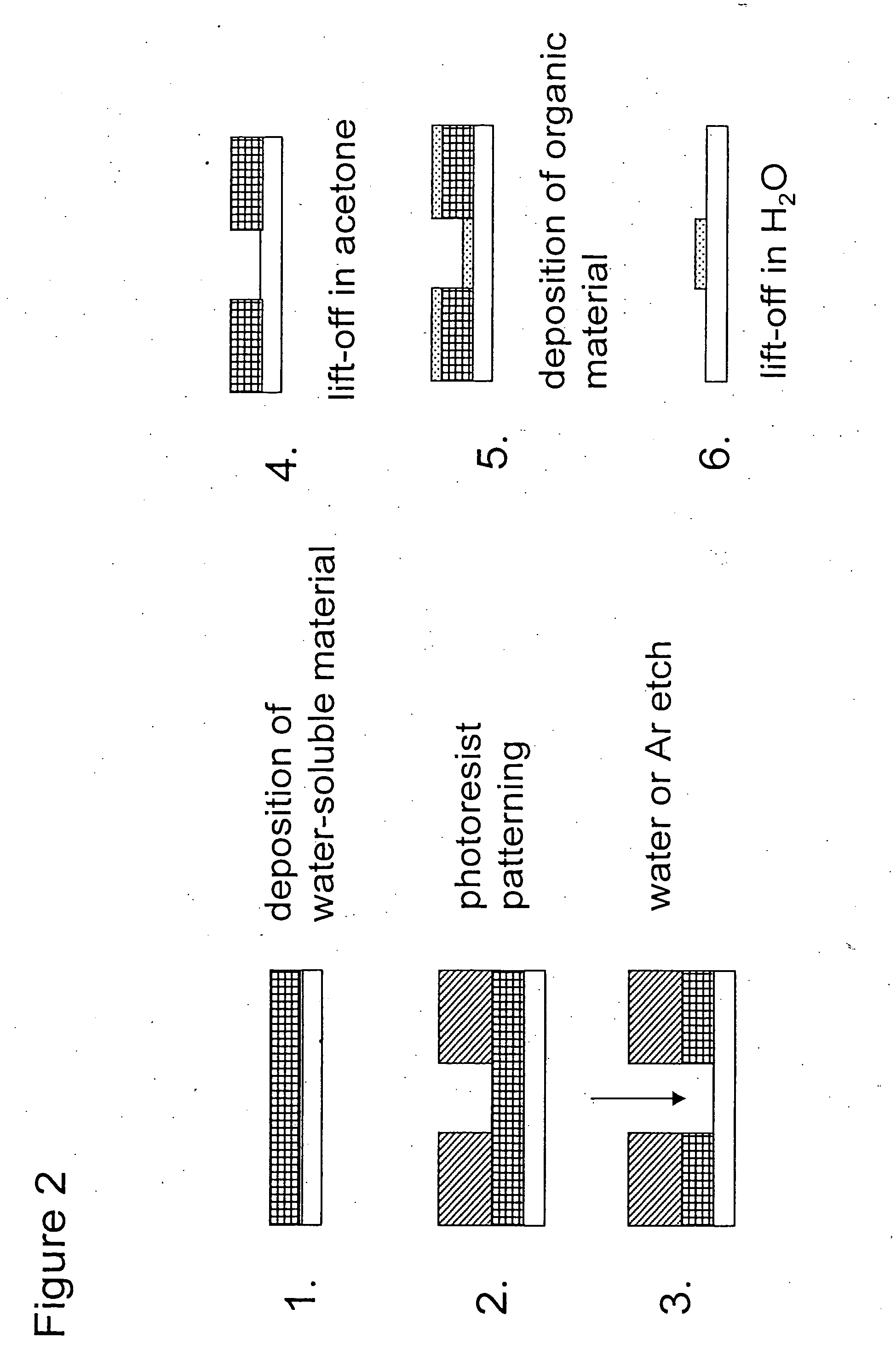Method for patterning organic materials or combinations of organic and inorganic materials
- Summary
- Abstract
- Description
- Claims
- Application Information
AI Technical Summary
Problems solved by technology
Method used
Image
Examples
example 1
Patterning Organic or Organic / Inorganic Materials—Route A
[0123] Step 1: A photoresist mask is patterned by either photolithography, electron beam lithography, or printing onto a solid or soft substrate (see Step 1 of FIG. 1.)
[0124] The thickness of the mask material “A” can be varied in large range between less than 1 nm and more than 2 μm. Preferably, the mask thickness should be larger than the thickness of the deposited material “B” (see below) in order to provide a successful lift-off.
[0125] In addition, it can be advantageous to cover the water-soluble mask by a thin layer of insoluble material like aluminium, ZrO2, or other materials that can form thin layers. This would stabilise the water-soluble mask during the process steps (against humidity, for example).
[0126] Step 2: 1 to 20,000 nm (preferably 20 to 1,000 nm) of water-soluble materials (material “A”) is deposited by thermal evaporation (including e-gun) or sputtering, or is spin-coated onto this photomask (see Step,...
example 2
Patterning Organic or Organic / Inorganic Materials—Route B
[0132] The above described process steps of Route “A” can also be arranged in a slightly different order. In this case, the water-soluble material “A” is deposited on a solid or soft substrate first and then, structures are introduced through a lithographic step on top of the water-soluble mask and subsequent water-etching.
[0133] Step 1: Typically 100 to 200 nm of water-soluble material (material “A”) is deposited by thermal evaporation (including e-gun), or sputtering, or is spin-coated onto a solid or soft substrate (see Step 1 of FIG. 2). The deposition rate can be in the range of less than 1 Å / s up to more than 100 nm / s. In the case that metallic material is deposited which has to be changed into a water-soluble oxide, the chamber can be partly (sputtering) or completely filled (preferably after deposition) with oxygen, oxygen plasma or ambient atmosphere. Material “A” can be any kind of water-soluble material from the g...
example 3a
Patterning of an Inorganic / Organic Composite Film Comprised of Gold Nanoparticles and Organic Linker Molecules (Route A)
[0143] In this example, it is demonstrated that a layer of Ca / CaO / Ca(OH)2 can be employed as water-soluble mask material “A” to pattern a composite film from gold nanoparticles and organic linker molecules.
[0144] Step 1: Standard Ti35zE or Az5214 photoresist was spin-coated onto a silicon wafer or glass wafer at 4,000 rpm to a final thickness of about 3 μm. After baking at 90° C. for 2 minutes, the resist was exposed for 10 seconds at 365 nm using a contact aligner. Then, the resist was developed in MIF826 developer for 1 to 2 minutes and rinsed with water.
[0145] Alternatively, UV6.06 electron beam resist was spin-coated at 4,000 rpm and baked at 130° C. for 60 seconds. Then the resist was exposed at 10 kV using a dose of about 15 μC / cm2. FIG. 3 shows an optical microscope picture of the electron beam resist structure after development.
[0146] Step 2: 25 to 200 ...
PUM
 Login to View More
Login to View More Abstract
Description
Claims
Application Information
 Login to View More
Login to View More - R&D
- Intellectual Property
- Life Sciences
- Materials
- Tech Scout
- Unparalleled Data Quality
- Higher Quality Content
- 60% Fewer Hallucinations
Browse by: Latest US Patents, China's latest patents, Technical Efficacy Thesaurus, Application Domain, Technology Topic, Popular Technical Reports.
© 2025 PatSnap. All rights reserved.Legal|Privacy policy|Modern Slavery Act Transparency Statement|Sitemap|About US| Contact US: help@patsnap.com



